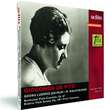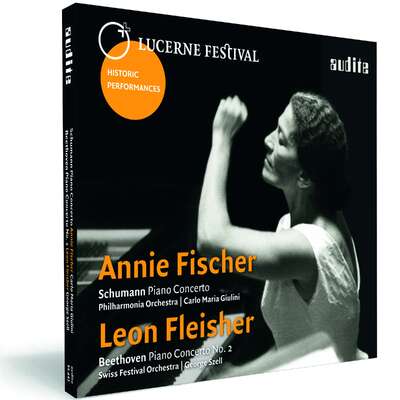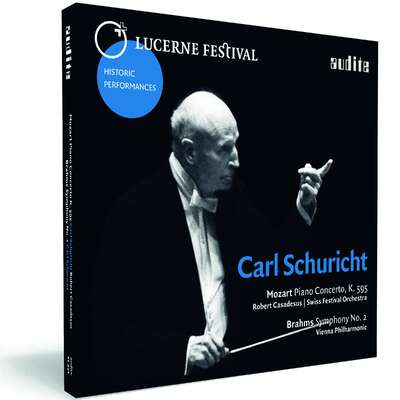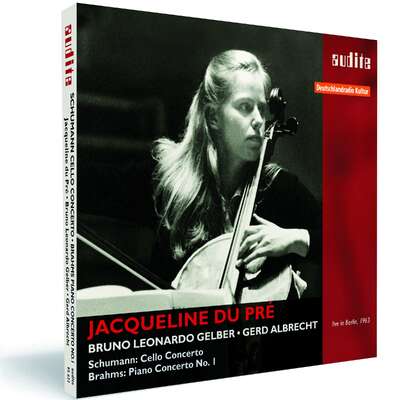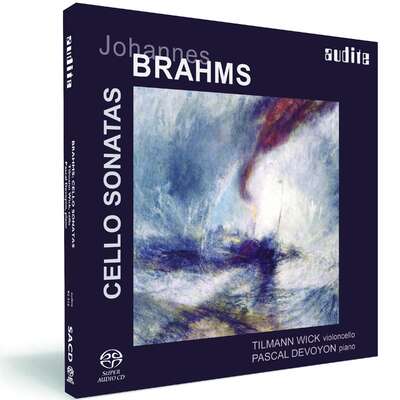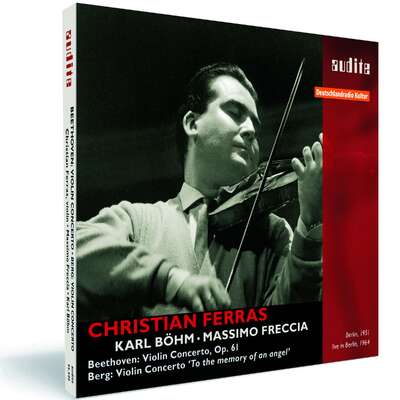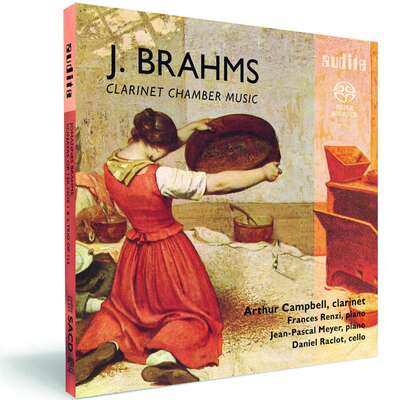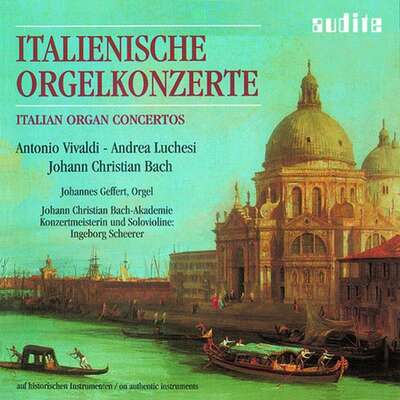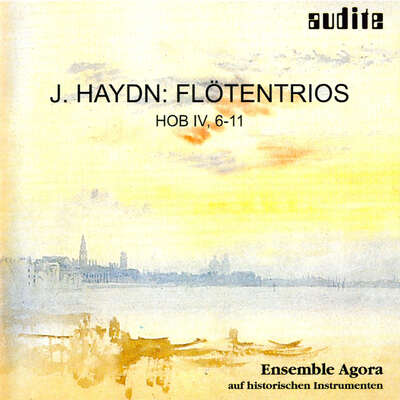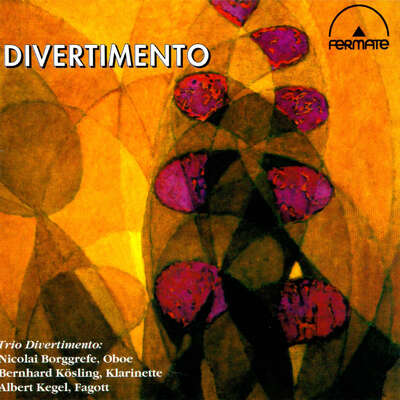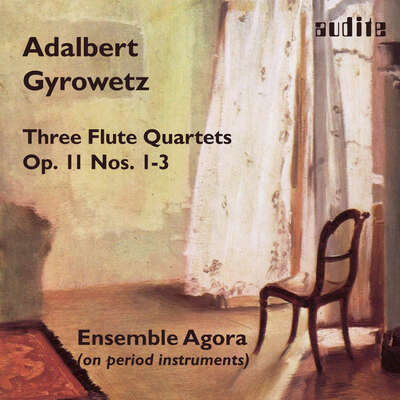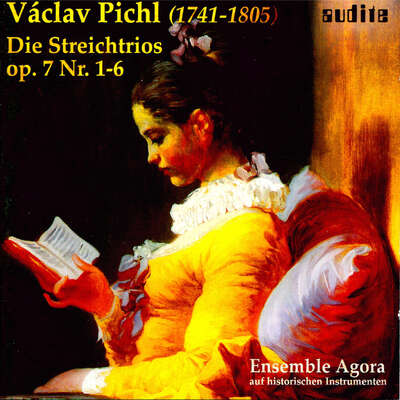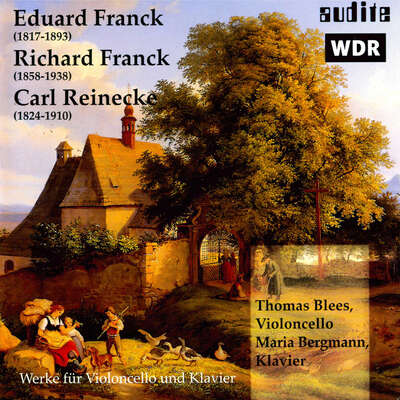
This live recording from 1954 of the Beethoven Violin Concerto with Gioconda de Vito and the RIAS Symphony Orchestra under Georg Ludwig Jochum is of particular documentary value as the Italian violinist made no studio recording of the work. Alongside music by Vitali and Brahms, her Beethoven interpretation comes to life thanks to her soulful, romantic tone.more
This live recording from 1954 of the Beethoven Violin Concerto with Gioconda de Vito and the RIAS Symphony Orchestra under Georg Ludwig Jochum is of particular documentary value as the Italian violinist made no studio recording of the work. Alongside music by Vitali and Brahms, her Beethoven interpretation comes to life thanks to her soulful, romantic tone.
Details
| Gioconda de Vito plays Beethoven, Brahms & Vitali | |
| article number: | 95.621 |
|---|---|
| EAN barcode: | 4022143956217 |
| price group: | BCB |
| release date: | 27. November 2015 |
| total time: | 79 min. |
Bonus Material
Informationen
Gioconda de Vito (1907-1994) was one of the few female violinists able to establish themselves as soloists on the concertplatform during the first half of the twentieth century. Born in the South Italian region of Puglia, the artist studied in Pesaro and Rome, accepting her first professorship at the tender age of seventeen. De Vito built an international career which took her as far afield as Argentina and Australia. In Germany she was especially highly regarded during the 1930s and 40s. Bach, Beethoven and Brahms represented the main pillars of her repertoire which, however, largely eschewed more modern music. De Vito cultivated a sumptuously romantic tone and never sought superficial violinistic brilliance. In 1961, aged only fifty-four, she retired from the concert stage. De Vito never recorded the Beethoven Violin Concerto in the studio: this sole live recording from 1954 with the RIAS Symphony Orchestra under the baton of Georg Ludwig Jochum presented here is therefore of particular documentary value.
Reviews
http://dl.bethrifkin.com | June 13, 2017 | June 13, 2017 | source: http://dl.bethri...
Alongside music by Vitali and Brahms, her Beethoven interpretation comes to life thanks to her [de Vito's] soulful, romantic tone.Mehr lesen
Mitteldeutscher Rundfunk | KONZERT HISTORISCH | 14.06.2016 | 10:05-12:00 Uhr | Alexander Gosch | June 14, 2016
BROADCAST
Als Frau an der Spitze einer männerdominierten Musikwelt
Eine Frau als Solistin vor dem Orchester? Das ist heute alltäglich, warMehr lesen
www.artalinna.com | 3 avril 2016 | Jean-Charles Hoffelé | April 3, 2016 Cordes et âmes II (De Vito versus Busch ?)
Le Concerto de Beethoven manquait à la discographie officielle de GiocondaMehr lesen
Audio | 03/2016 | Andreas Fritz | March 1, 2016
Auf Hochglanz poliert sind diese Mono-Aufnahmen von 1951 und 1954: Sie zeigen die Geigerin Gioconda de Vito auf dem Höhepunkt ihrer Kunst. Ihr sehrMehr lesen
BBC Music Magazine | March 2016 | Erik Levi | March 1, 2016
De Vito imbues every note in Beethoven's Violin Concerto with such heartfelt intensity that it's impossible not to be mesmerised by her hyper-RomanticMehr lesen
Record Geijutsu | FEB. 2016 | February 1, 2016
Japanische Rezension siehe PDF!Mehr lesen
MJ | FEB. 2016 | February 1, 2016
Japanische Rezension siehe PDF!Mehr lesen
Der neue Merker | 27. Dezember 2015 | D. Zweipfennig | December 27, 2015 Historische Kostbarkeiten – Erich Kleiber mit seinem legendären Rosenkavalier u. m. / Gioconda de Vito mit Beethovens Violinkonzert
Das musikalische Resultat, wo auch eine temperamentvolle Virtuosität nicht zu kurz kommt, spricht jedenfalls für sich. Es gebiert jenseits des einfachen Hörvergnügens jenen Zauber, der einen euphorisch über die Welt schweben lässt.Mehr lesen
www.pizzicato.lu
| 27/12/2015 | Remy Franck | December 27, 2015
Aus dem Notizbuch eines Rezensenten – CD-Kurzkritiken von Remy Franck (Folge 96)
Hommage an Gioconda De Vito
Die italienische Geigerin Gioconda De Vito (1907-1994) beschloss im Alter von 53, keine Aufnahmen mehr zu machen. 1961 hörte sie gar ganz mit demMehr lesen
www.musicweb-international.com | December 2015 | Stephen Greenbank | November 25, 1015
It was the ‘3 Bs’ that formed the core of Gioconda de Vito’s rather limited repertoire. She shunned violinistic showpieces, preferring to focusMehr lesen
De Vito carved out a successful career for herself at a time when violin concertising was very much a male bastion. Erica Morini, Johanna Martzy, Ginette Neveu, Camilla Wicks and Ida Haendel made similar inroads. As well as tramping the concert circuit, she forged a parallel teaching career. In 1949, she married David Bicknell, an EMI executive producer and, from 1951, lived in the UK; she never really mastered the English language, often needing a translator. Strangely, she was only fifty-four when she retired, never performing or teaching again, living happily in retirement in her cottage in Hertfordshire, England. She died in Rome in 1994, aged 87.
The contents of Audite’s release are all new to the violinist’s sparse discography, which makes the disc all the more welcome. She never recorded the Beethoven Violin Concerto in the studio, neither are there any other extant live airings apart from this 1954 RIAS performance. It attests to a congenial partnership between soloist and conductor. The opening movement is broad and spacious and has nobility and stature. De Vito savours the sublime lyricism of the score, judging the ebb and flow of the music instinctively. I didn’t recognize the cadenza she uses, and Ruggiero Ricci’s Biddulph recording, including fourteen alternative cadenzas, didn’t come up with any answers. I liked it anyway – maybe it was her own. The slow movement is eloquent and imaginatively phrased and in the finale her bowing has real bite and tenacity. Intonation throughout is, for the most part, on the mark. This is a performance which certainly brings the music to life. The sound quality is excellent, not sonically compromised like some of her live airings I’ve heard that have hit the market-place over the years. The audience members were extremely well-behaved, and I only detected their presence between movements – the odd rustle and suppressed cough.
The Brahms Violin Sonata No. 2 in A major, Op. 100, with Michael Raucheisen, pre-dates the commercial recording she made at the Abbey Road Studios in London by five years. In that recording, Tito Aprea took the piano part, completing the HMV trilogy begun in 1954 with Edwin Fischer. Surprisingly, the audio quality of Audite’s Berlin traversal far exceeds that of the later version: Testament SBT1024. The sound is more vivid and bright. Interpretively there is less divergence. The players convey the intimacy, affection and luminous warmth that permeates the music. The first movement is spacious and relaxed. Joy and affability abound in the second movement, and an ardent glow suffuses the finale.
In 1948, de Vito made a commercial recording of the Vitali Chaconne, again at Abbey Road, London, in the orchestral version arranged by Ottorino Respighi. Her accompanists were the Philharmonia and Alberto Erede. Here Michael Raucheisen supports her, and takes a bit of a backseat, allowing the violinist, who is very forwardly projected, the spotlight. The opening theme is announced boldly and majestically, and as each variation becomes progressively more demanding, De Vito maintains the cumulative thrust with astounding virtuosity. I do confess to having a predilection for organ accompaniment in this work, my taste persuasively formed by my first encounter with it in the unsurpassable version by Jascha Heifetz.
This release fills a notable gap in the violinist’s discography and receives my wholehearted endorsement.
